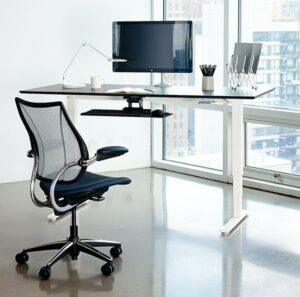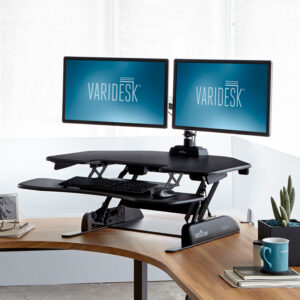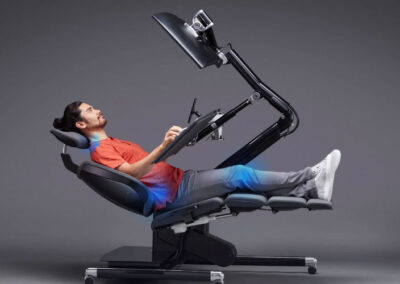
Sit/Stand Desks: A Review And Critique
Review by Ricky Fishman, DC
Both my patients and non-patients ask me about sit/stand desks. They are all the rage. Many of the workplaces I visit are open-plan and stocked with various versions of these up/down desks, which enable computer workers and others who rely on monitors to change positions throughout the day.
The popularity of the sit/stand desk has given rise to a burgeoning market. There are lots of choices at a variety of price points. There are several things that determine the best choice for an individual or a company: They include space, look, ease of use and budget. I’d like to describe the pros and cons of some of the top models in the marketplace.
Full sit/stand desks

Humanscale Float
Starting at the high end is the Humanscale float table. Priced at close to $2000, it is the sit/stand desk I have in my office. Elegant in its simplicity–a beautiful laminate top with steel and aluminum legs and hardware–the float has a hydraulic lift which makes positioning fast and easy. One critique, however, is that I have had problems with jamming of the hydraulic lift. This required a one-time replacement of the frame by Humanscale; not something one expects with a top-of-the-line product.
There is a big drop in price as we move to the electric models. Priced well below $1000 (and as low as $399), most models come with up to four height settings.

Jarvis Sit/Stand
There are beautiful wood tops to choose–from maple to oak to bamboo.
Also available are modern tops made of composites which can be better aesthetic fits for a high tech setting. Steel legged foundations with motorized lifts in a variety of finishes can be mixed and matched.
Converters
Going down another price point, we find the desk top converters. These are generally “out of the box” units: They get put on top of a desk that is already in place. The original model, and still an industry leader, is Varidesk. Instead of having a motorized lift, there is a hydraulic one. I personally prefer the hydraulic as it slips into the desired position easily without having to wait for the motor to do its job. It is a bit sad that waiting just a few seconds has become an irritant in our age–but that small irritation is enough to discourage some people from using the sit/stand function.  One of the down sides of converters (Jarvis offers one as well) is that the base stand occupies a good deal of desktop space, eliminating an area that could be used for documents or other work items. Finally, because they frequently don’t match the desk they sit on, the converter aesthetic may not be as pleasing as a designated sit/stand.
One of the down sides of converters (Jarvis offers one as well) is that the base stand occupies a good deal of desktop space, eliminating an area that could be used for documents or other work items. Finally, because they frequently don’t match the desk they sit on, the converter aesthetic may not be as pleasing as a designated sit/stand.
Monitor arm is essential
With either the full motorized desk or the converter, a movable monitor arm is essential. This is because the mechanical relationships change when moving from sitting to standing positions and back; The wrist/arm/shoulder/head positions for sitting might be correct; but when moved into standing position, the mechanics of the body change, and so monitor’s height must be adjusted. With a monitor arm that moves up and down, side to side, closer to the eye and further away, the ergonomics can easily be adjusted.
The equipment is not enough! It’s about movement!
Sit/stand desks can be like gym memberships. People are so excited when they get one. For the first month, they use them every day, often throughout the day. Then maybe half the time the next month. And after that, all too frequently, they revert to staying in one position: usually seated. The equipment doesn’t help if it isn’t used. And you won’t get those six pack abs without using that crunch machine!
People are different
For some people, spending most of the day in standing position is appropriate. There are high stools available to relieve this. Some have fixed bases, while others are mobile, or wobble. The latter engage the core throughout the day, while the former allow a person to keep their desk in standing position, while stepping on and off the stool.
Becoming human
Like our ancient relatives who roamed the African savannas, humans are built to move. We were not designed to be in one position all day. But because the modern workplace is organized around generating profits and not primarily around the health and wellbeing of the workers who generate those profits, our bodies can (and often do) break down. But a new understanding of biomechanics and ergonomic design has enabled us to have our work spaces more closely align with who we are as bio-mechanical beings.
I encourage everyone–if you have the space and the budget–to convert to sit/stand. Get a good chair as well, and a monitor arm. And take advantage of your new set up! If need be, set an alarm on your phone to signal you to change positions. Stand up, roll your shoulders, take five deep breaths, walk around the office…Or even better, get out of the office!
Copyright 2019
Dr. Ricky Fishman has been a San Francisco based chiropractor since 1986. In addition to the treatment of back pain and other musculoskeletal injuries, he works as a consultant in the field of health and wellness with companies dedicated to re-visioning health care for the 21st century.











